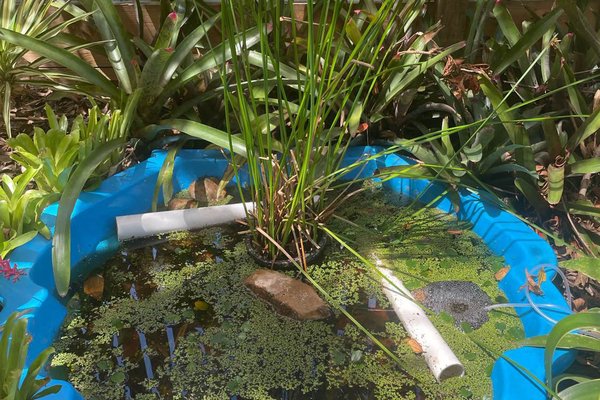Where are Australia’s frogs? Introducing the latest Australian Frog Atlas
The latest Australian Frog Atlas is available to download here.
With seven new frog species described to science and over a million frog records at our fingertips, we revise and update the Australian Frog Atlas – the most detailed, up-to-date distribution maps of all Australia’s 254 frog species.
A detailed understanding of where species occur is vital to help ensure their conservation. It might seem like something obvious that we would already have a good understanding of, but in fact it is very poorly known for most of Australia’s biodiversity. Until recently, this has been particularly true for some of our most threatened animals - frogs.
In June 2022, we released the Australian Frog Atlas – at the time, the most detailed distribution maps of Australian frogs. Largely informed by expert-validated occurrence records from the Australian Museum’s citizen science project, FrogID, and incorporating records from published literature and the Atlas of Living Australia, we explored frog occurrence records throughout Australia to provide highly detailed maps of 247 frog species. However, with FrogID recently surpassing one million frog records, and recent scientific advances in our understanding of Australia’s frog diversity, it was time for an update!

© Australian Frog Atlas/Australian Museum
The new, updated version of the Australian Frog Atlas has made changes to the maps of almost all species, incorporating small and large range extensions. It’s also added maps for the seven species of Australian frogs that have been scientifically described since the first version (most of them with the help of FrogID data!): the Southern Stuttering Frog (Mixophyes australis), Otway Smooth Frog (Geocrinia sparsiflora), Scarlet-sided Banjo Frog (Limnodynastes grayi), Coastal Banjo Frog (Limnodynastes superciliaris), South Australian Tree Frog (Litoria calliscelis), Kangaroo Island Tree Frog (Litoria sibilus), and Western Laughing Tree Frog (Litoria ridibunda). In addition, four frog species from Western Australia have been re-classified as the newly-described genus Anstisia. By including these new species in the updated version of the Australian Frog Atlas, we now have detailed distribution maps for all 254 described Australian frog species.

© Jodi Rowley
For the species included in version 1 of the Atlas, most range extensions have been made thanks to FrogID recordings. While most of these updates have been relatively small map revisions, there have been several large, exciting updates. For example, new FrogID recordings of the poorly-known Cave Frog (Litoria cavernicola) from the Kimberley region in northwest Western Australia have resulted in a 100km south-west extension in the distribution of the species, expanding its known range by 13%! Likewise, new FrogID recordings from remote Queensland have revealed that the Blacksoil Toadlet (Uperoleia trachyderma) occurs over 300km further south-west than we originally thought, also resulting in a 13% range increase! These new records from poorly-sampled, remote areas of the country are providing us with invaluable insight into frog biodiversity and distributions.

© Bob Elliot
Improving FrogID sampling coverage across Australia is key to improving our knowledge of species distributions, particularly within remote areas of the country. To help citizen scientists know which areas are not well-sampled, we have divided the entire map of Australia into 0.5 decimal degree grid cells (roughly 55km), and provided a map of the number of FrogID recordings made within each cell. To date, FrogID citizen scientists have recorded frogs across 37% of Australia - which is incredible, but leaves so much of the country to survey! By targeting poorly-sampled regional and remote areas, FrogID citizen scientists are able to reveal insights into the distribution of our frogs, and help to ensure the Australian Frog Atlas remains a highly detailed and current resource for conservation.
The updated version of the Australian Frog Atlas is Open Access and available to download. These publicly-available resources include detailed KML files, shapefiles, and a map of species richness across Australia. By submitting recordings to the FrogID app, thousands of citizen scientists are really helping to put Australian frogs on the map, expanding our knowledge and understanding of frog distributions, and helping to conserve some of Australia’s most threatened biodiversity.
Grace Gillard, Research Assistant, Herpetology, Australian Museum Research Institute
Dr Jodi Rowley, Curator, Amphibian and Reptile Conservation Biology, Australian Museum & UNSW Sydney. Lead Scientist, FrogID.
Timothy Cutajar, Research Assistant, Herpetology, Australian Museum Research Institute
Acknowledgements:
We would like to thank the Citizen Science Grants of the Australian Government and the Impact Grants program of IBM Australia for providing funding and resources to help build the initial FrogID App; the generous donors who have provided funding for the project including the James Kirby Foundation; the NSW Biodiversity Conservation Trust and the Department of Planning and Environment – Water, and the Saving our Species program as Supporting Partners; the Museum and Art Gallery of the Northern Territory, Museums Victoria, Queensland Museum, South Australian Museum, Tasmanian Museum and Art Gallery, and Western Australian Museum as FrogID partner museums; the many Australian Museum staff and volunteers who make up the FrogID team; and, most importantly, the thousands of citizen scientists across Australia who have volunteered their time to record frogs.
More information:
- Australian Frog Atlas 2.0
- Cutajar, T.P., Portway, C.D., Gillard, G.L., and Rowley, J.J.L. (2022) Australian Frog Atlas: Species’ distribution maps informed by the FrogID Dataset. Technical Reports of the Australian Museum, Online 36: 1-48. https://doi.org/10.3853/j.1835-4211.36.2022.1789.













